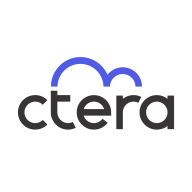

Find out in this report how the two Disaster Recovery (DR) Software solutions compare in terms of features, pricing, service and support, easy of deployment, and ROI.
Azure Site Recovery, while being pricier than some providers, has a sufficient service level to justify costs.
Azure Site Recovery is time-saving, and its features allow us to automate processes and save resources.
Adding SSD storage to Windows file servers is expensive, and we no longer need to back up those devices.
I am positive that CTERA has helped reduce the total cost of ownership by eliminating the need for manual storage management and reducing storage service processes.
During a global outage that affected our operations, there was no apology or in-depth follow-up from Microsoft.
Microsoft support could be improved as it rates only a five out of ten, with slow response times and a preference for email over phone communication even in severity B cases.
We primarily rely on our Cloud Support Partner for support.
They swiftly address concerns and take ownership of the call, providing a very satisfactory support experience.
High-priority issues are handled promptly.
I would rate their support a ten out of ten.
I would rate the scalability of Azure Site Recovery as a nine out of ten.
Scalability is provided because they are offering 99.95% availability.
Azure Site Recovery is a very scalable product and service mechanism.
If we need to upgrade CPU and memory, we should be able to do that without a license upgrade.
CTERA is a very scalable product, allowing us to grow.
It offers good scalability options, including vertical and outward scalability.
The system did go down a couple of times, which impacted our operations.
I would rate the stability of Azure Site Recovery at eight to nine out of ten.
It has been pretty stable since then.
We had things deployed for years, and we were suddenly getting cloud sync issues that were crashing our sites.
It is very stable and reliable.
If their agent version is mismatched and the health status is critical, you will not be able to perform your Azure Site Recovery.
There is room for improvement in the release of patches, such as ensuring they are properly managed to avoid outages.
Currently, Azure Site Recovery does not support shared disk options.
AI and automation features could enhance the platform, such as AI-powered search, predictive storage analytics, and intelligent alerts for proactive monitoring.
The main problem is that if two people are working on the same file, for example, one in the U.S. and one in Israel, they can overwrite each other’s work without any notification.
It would help to have a global single-pane-of-glass view of all my CTERA devices.
It was not the expensive part of our costs.
A major advantage is that you do not want to pay any more for huge costs to build a DR site.
The pricing of Azure Site Recovery is around a four out of ten, being somewhat cost-effective.
Unlike other solutions that require hardware purchases, CTERA offers software licensing with flexibility across multiple infrastructure providers.
CTERA’s pricing should be more proportional and accessible so that cost is not the factor preventing customers from purchasing.
CTERA's pricing seems to be on par with some of the other players, such as Nasuni and Azure.
Its time-saving aspects allow us to write PowerShell scripts to automate failover processes.
Azure provides a 99.99% SLA for their uptime, ensuring that even during outages due to patch releases, there is no data loss, merely hindered accessibility.
The most valuable features of Azure Site Recovery are its ease of use and speed of recovery.
As soon as something is written to the device, CTERA copies it to the cloud, where it's versioned with snapshots so we can recover it.
A vital advantage of this platform is its instantaneous recovery capability, allowing seamless access to a secondary gateway if the primary one fails.
It is a three-in-one solution for us. It is a file-sharing platform, an archiving solution, and also a backup solution.


| Company Size | Count |
|---|---|
| Small Business | 8 |
| Midsize Enterprise | 4 |
| Large Enterprise | 14 |
| Company Size | Count |
|---|---|
| Small Business | 2 |
| Midsize Enterprise | 2 |
| Large Enterprise | 6 |
Help your business to keep doing business - even during major IT outages. Azure Site Recovery offers ease of deployment, cost effectiveness, and dependability. Deploy replication, failover, and recovery processes through Site Recovery to help keep your applications running during planned and unplanned outages. Site Recovery is a native disaster recovery as a service (DRaaS), and Microsoft been recognized as a leader in DRaaS based on completeness of vision and ability to execute by Gartner in the 2018 Magic Quadrant for Disaster Recovery as a Service.
The CTERA Enterprise File Services Platform provides a cloud-native global file system over public and private object storage, revolutionizing the world of hybrid cloud data solutions. Enhanced by a rich data services ecosystem, CTERA enables enterprises to gain full control of their data for optimal edge performance, data insight, and governance. The platform focuses on security, providing features like data encryption, access controls, and ransomware protection. Centralized management tools enable efficient data control and monitoring. The platform is being used to replace legacy NAS and file servers, especially at remote locations, and simplify backup and disaster recovery of file data while providing the flexibility of multi-cloud deployments with infinite scalability. CTERA is at the core of hybrid cloud transformations of some of the world’s largest banks, healthcare organizations, global media groups, and government agencies, in deployments that scale to tens of petabytes.
We monitor all Disaster Recovery (DR) Software reviews to prevent fraudulent reviews and keep review quality high. We do not post reviews by company employees or direct competitors. We validate each review for authenticity via cross-reference with LinkedIn, and personal follow-up with the reviewer when necessary.